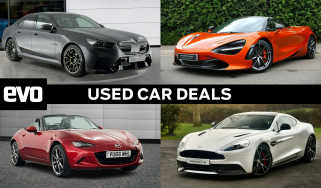Ford Focus ST review – engine, gearbox and technical specs
Four-cylinder engine is powerful, but lacks flexibility; gearboxes only average
By class standards there’s a fairly big lump sitting under the ST’s bonnet in the form of a turbocharged 2.3-litre, or 2261cc if you prefer, four-cylinder engine. If it sounds familiar, it’s because it’s the same engine found largely in American-market Fords, including but not limited to the Ranger pick-up, Bronco and Mustang.
This explains why the ST’s torque figure of 310lb ft is so much more impressive than its 276bhp, beating out all main rivals for torque but lagging in power. This manifests itself in the engine’s delivery, with a solid pick-up from low rpm that will happily trouble the front wheels. Keep the throttle pinned, though, and the engine’s enthusiasm wanes as the revs rise, and doesn’t quite portray the excitable nature we all expect in a hot hatchback.
Ford incorporates a sort of anti-lag system for the turbo, but it’s a far cry from the flame-spitting systems that kept setting 1980s rally cars on fire. Instead, the Focus keeps the electronically controlled throttle valve open for short periods of time after coming off the throttle to keep the turbo spinning. The system does work, sort of, but is only really obvious with large sustained inputs on and off the throttle, which is only generally relevant on track.
More reviews
Group tests
In-depth reviews
Reviews
Speaking of which, the ST is available with a Track Pack for an extra £3000, bringing a host of performance-focused upgrades to make the car more capable and resilient on a circuit. They key change is the fitment of adjustable KW coilovers with 12 clicks of bump adjustment and 16 rebound settings, as well as a 10mm lower ride height (this can be dropped by a further 15mm if you're handy with spanners). A set of lighter 19-inch wheels are included too, wrapped in a bespoke Pirelli P Zero Corsa tyre with uprated Brembo brakes featuring larger 363mm discs (up from 330mm) at the front.
A six-speed manual transmission is standard fit, with a conventional seven-speed auto optional. Power is sent to the front wheels, and thanks to the incorporation of the previously optional Performance Pack into the base spec, is driven through an electronically controlled limited-slip differential. The manual also has rev-matching and launch control functions.
The automatic is a standard torque converter-style unit rather than a dual-clutch, and has insistent, if not entirely speedy, shifts. The bigger problem, though, is the extra inertia it appears to add to the driveline, making the already slightly blunt engine feel even softer. There are paddles behind the steering wheel, though, and the previous car’s irritating dial-like gear selector has also been swapped out for a traditional lever.
Kerb weights for both hatchback and estate are on the heavier side, due in no small part to the big engine. They come in at 1433kg for the hatchback and 1468kg for the estate.





